Archive Record
Images
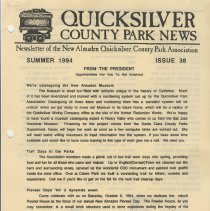
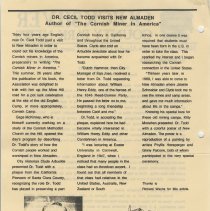
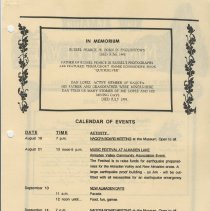
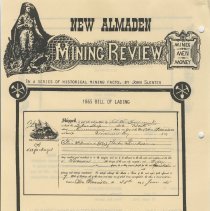
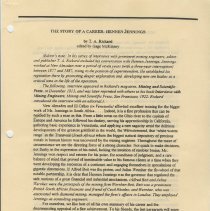
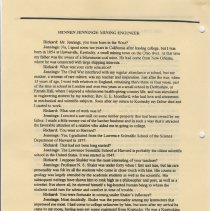
Additional Images [9]
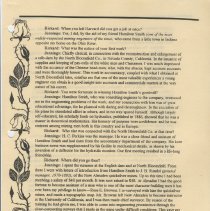
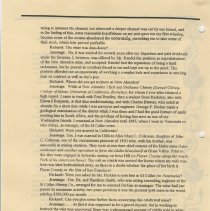
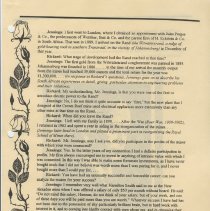
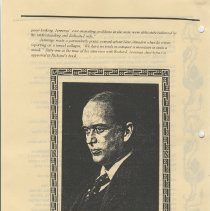
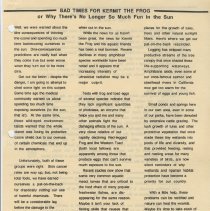
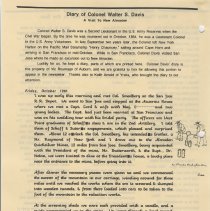
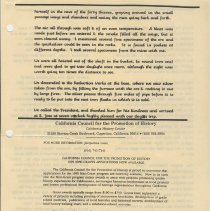
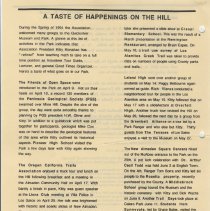
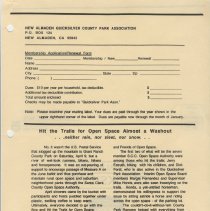
Metadata
Catalog number |
1997.2.2610 |
Object Name |
Newsletter |
Date |
1994 |
Description |
TITLE: Quicksilver County Park News SUBTITLE: Newsletter of the New Almaden Quicksilver County Park Association Issue # 38 Summer 1994 SUMMER 1994 ISSUE 38 FROM THE PRESIDENT Opportunities For You To Get Involved We're cataloguing the New Almaden Museum The Museum is small but filled with artifacts unique in the history of California. Much of it has been inventoried and marked with a numbering system set up by the Quicksilver Park Association. Cataloguing all these items and numbering them into a standard system will be critical when we get ready to move our Museum to as future home, which will be a replica of the quicksilver Mining Company office at the site of the former Reduction Works. We're happy to have found a museum cataloguing expert in Nancy Valby who comes to us from the San Jose Historical Museum. Financing for the project comes from the Santa Clara County Parks Department. Nancy will begin her work as soon as a few computer kinks are worked out. She will need some willing volunteers to input information !MO the system. If you have some time available and would lice to have sane training in this type of work give me a call. We need you. Trail Days in the Parks The Association members made a picnic out of two trail work days this spring, providing food and fun for all those who came and helped. Up in English(Cornish)Town we cleaned out the barn and surrounding areas, spruced up the wonderful CCC monument and painted over graffiti inside the mine office. Over at Calero Park we built a connecting trail for hikers, runners ant equestrians. Call me H you'd like to get on the list for the next trail cleanup days. Pioneer Days '94: a dynamite event Come celebrate with us on Saturday, October 8, 1994, when we dedicate the rebuilt Powder House as the focus of our annual New AImaden Pioneer Day. The Powder House, as you may remember, is a small bride structure used to store explosives during the heyday of the mining operations. It suffered considerable damage during the 1989 earthquake. Thanks to persistence of the Parks Department and some Federal Emergency (FEMA) money, the building was returned to its pristine beauty. We'll celebrate its rebirth with a real old time miners' meal and lots of fun. Association members will receive a personal Invitation to the event in September. tt you're not a member, now's a good time to fill out the form on the bade of the newsletter and send h in. Kitty Monahan, President 268-6541 DR. CECIL TODD VISITS NEW ALMADEN Author of "The Cornish Miner in America" Thirty four years ago Englishman Dr. Cecil Todd paid a visit to New Almaden in order to round out his knowledge of the Cornish miners in America, preparatory to writing 'The Cornish Miner in America. ' This summer, 26 years after the publication of his book, the Association was delighted to trek with him up the Mine Hill road for a pot luck celebration at the side of the old English Camp, a more appropriately, Cornish Camp. Gage McKinney, who is himself currently waking on a study of the Cornish Methodist Church on the Hill, opened the day's program by describing Dr. Todd's story of how the Cornish people worked and worshiped in New AImaden. City Historian Clyde Arbuckle presented Dr. Todd with a plaque from the California Pioneers of Santa Clara County, recognizing the role Dr. Todd has played in preserving a part Cornish history in California and throughout the United States. Clyde also told an Arbuckle anecdote abort how he became acquainted with Dr. Todd. 'Dutch Hammon, then City Manager of San Jose, received a letter from Dr. Todd requesting information about William Henry Eddy, one of the heroes of the 1846 Reed-Donner Party. He passed the letter on to.me, beginning a long friendship between Cecil and me.' DrTodd, in accepting the plaque, explained how he had become vitally interested in William Henry Eddy and other Cornishmen in America. 'I was lecturing at Exeter University in Cornwall, England in 1947, when I noticed that many people in the class had an American acct. I found out that all members of that class had relatives in the United States, Australia, New Zealand or South Africa. In one course it was required that students must have been born in the U.S. in order to take the class. This sparked my interest and I began researching the Cornish connection in the United States. "Thirteen years later, in 1960, I was able to came to New Almaden where Jimmie Schneider and Clyde took me to see the mines and camp areas, and gave me much information about life in the camps.' Knowing his special love for these old mining camps, Kitty Monahan presented Dr. Todd with a colorful poster of New AImaden. The poster is a reproduction of a painting by artists Phyllis Hensperger and Ginny Falcone, both of whom participated in the very special ceremony. Thanks to Richard Wachs for this article. IN MEMORIUM RUSSEL PEARCE JR BORN IN ENGLISHTOWN DIED June, 1994 FATHER OF RUSSEL PEARCE III RUSSEL'S PHOTOGRAPHS ARE FEATURED THROUGHOUT JIMMIE SCHNEIDER'S BOOK "QUICKSILVER" DAN LOPEZ ACTIVE MEMBER OF NAQCPA, HIS FATHER AND GRANDFATHER WERE MINERS HERE. DAN TOLD US MANY STORIES OF JOE LOPEZ AND HIS MINING DAYS DIED JULY 1994. CALENDAR OF EVENTS DATE TIME ACTIVITY August 10 7 p.m. NAQCPA at the Museum. Open to all. August 21 12 noon-5 p.m. MUSIC FESTIVAL AT ALMADEN LAK Almaden Valley Community Association Event. The Festival is to raise funds for earthquake prepared- ness for the Almaden Valley and New Almaden areas. A large earthquake proof building - an Ark - will be out- fitted with all necessities for an earthquake emergency. September 10 NEW ALMADEN DAYS 11 a.m. Parade 12 noon until Food, fun, games September 14 7 p.m. NAQCPA BOARD MEETING at the Museum. Open to all. October 8 PIONEERDAYS 11 a.m Meet at Reduction Works for drive up the Hill. 12 noon Picnic lunch, entertainment, and dedication of newly- restored Powder House. NAQCPA BOARD MEETING at the Museum. Open t0 all. NEW ALMADEN MINING REVIEW IN A SERIES OF HISTORICAL MINING FACTS. BY JOHN SLENTER 1865 BILL OF LADING (34 THIS RARE DOCUMENT IS A BILL OF LADING FOR THE SHIPMENT OF 500 FLASKS OF QUICKSILVER FROM THE PORT 0F SAN FRANCISCO. IT WAS ON A BRITISH SHIP CALLED THE VISCATA WITH A PORT DESTINATION OF "SWANSEA" ENGLAND. THE BILL STATES THE FLASKS ARE SHIPPED QUICKSILVER ORDERS OF SAMUEL F. BUTTERWORTH, THE FIRST PRESIDENT OF THE QUICKSILVER MINING C0. 1864-1870 THE STORY OF A CAREER: HENNEN JENNINGS by T. A. Rickard edited by Gage McKinney (Editor's note: In his series of interviews with prominent mining engineers, editor and publisher T. A. Rickard included his conversation with HermenJennings. Jennings worked at ,New Almaden over a period of.seven years (with a three year interruption) between 1877 and 1881, rising to the position of superintendent He established !its reputation there by promoting deeper exploration and developing new ore bodies at a critical time in the life of the operation The following interview, appeared in Rickards magazine. Mining and Scientific Press. in December 1915, and was later reprinted with others in his book book Interviews with .Mining Engineers, :Mining and Scientific Press. San Francisco, 1922. Rickard introduced the interviews with an editorial.). New Almaden and El Callao (in Venezuela) afforded excellent training for the bigger work of Mr. Jennings in South Africa . . . . Indeed, it is a line profession that can be typified by such a man as this. From a little town on the Ohio river to the capitals of Europe and America he followed his destiny, serving his apprenticeship in California, gathering basic experience in Venezuela, and applying a rare sagacity amid the delirious developments of the greatest goldfield in the world, the Witwatersrand, that 'white waters range' in the Transvaal (.South Africa) where the biggest natural depository of precious metals in human history was uncovered by the mining engineer. Throughout the maze of circumstance we see the directing force of a strong character. Not quick to make decisions, not flashy in the expression of his mind, lacking the intuition of nimbler brains, Mr. Jennings won respect and esteem for his poise, for soundness of judgment, and a rare balance of mind that proved of inestimable value to his famous clients at a time when they were developing the resources of a continent and engaging themselves in speculations of -gigantic dimensions. If Alfred Beit was the piston and Julius Wernher the tlv-wheel of that notable partnership, it is clear that Hennen Jennings was the governor that regulated the safe motions of a great financial and industrial mechanism. Alfred Beit and Julius Werner were the principals of the mining firm Werner-Beit . Beit was a prominent British Smith .African financier and friend of Cecil Rhodes: and Werner, who was associated with diamond mining, managed the firm's affairs m London. They employed Jennings as consulting engineer). For ourselves, we like best of all his own summary of his career and the discriminating appraisal of a fine achievement. To his friends, the last paragraph will seem characteristically modest; to the younger men it conveys the clear lesson that little of enduring value can be achieved without cooperation, the ability to enlist the sympathetic help of others, the unselfishness to give them HENNEN JENNINGS: MINING ENGINEER Rickard: Mr. Jennings, you were born in the West? Jennings: No, I spent some ten years in California after leaving college, but I was born in 1854 at Hawesville, Kentucky, a small mining town on the Ohio civet. At that time my father was the owner of a bituminous coal mine. He had come from New Orleans, where he was connected with large shipping interests .... Rickard: What was your early education? Jennings: The Civil War interfered with my regular attendance at school, but my mother, a woman of rare culnue, was my teacher and inspiration. Just after the war, when 13 years of age, I went with relatives to England, remaining there three or four years, part of the time at school in London and over two years at a small school in Derbyshire, at Famah Hall. where ( enjoyed a wholesome health-giving country life, and was stimulated in engineering matters by my teacher, Rev. E. E. Montford, who had love and attainment in mechanical and scientific subjects. Soon after my return to Kentucky my father died and I started to work. Rickard: What sort of work was it? Jennings: I erected a saw-still on some timber property that had been owned by my father. I made a little money out of the lumber business and in such a way that it attracted the favorable attention of a relative who aided me in going to college. Rickard: You went to Harvard? Jennings: Yes, I graduated from the Lawrence Scientific School of the Science Department of Harvard in 1877. Rickard: That had not been long started? Jennings: The Lawrence Scientific School at Harvard is probably the oldest scientific school in the United States. It was started in 1847. Rickard: I suppose Shaler was the most interesting of your teachers? Jennings: Professor N. S. Shaler was under forty when I fast met him, but his rare personality was felt by all the students who came in dose touch with him. His course in geology was largely attended by the academic students as well as the scientific. His subsequent writings have shown him to rank high as a philosopher and poet, as well as a scientist. Hut above sit he showed himself a big-hearted human being to whom the students could rum for advice and comfort in time of trouble .... Rickard: You were fortunate in coming tinder Shaler's influence? Jennings: Moat decidedly. Shaler was the personality among my instructors that impressed me most. I had come to college unknown by him, but soon after my arrival he came to my room, having seen my name registered from Kentucky. He was a Kentuckian. He thought I might be lonely and came to give me a friendly welcome. He invited me to his house and I had the privilege of considering him a true friend as well as teacher until his death Rickard: You took the course in Mining Engineering Jennings: No. The mining course was not then well established I took the course in Civil Engineering, which gave all the preliminary training required for mining engineering. I obtained the degree of Civil Engineer in 1877 . . . . Rickard: when you left Harvard did you get a job at once'? Jennings: Yes, I did, by the aid of my friend Hamilton Smith one of the most widely-respected mining engineers of the times, who came from a little town in Indiana opposite my home on the Ohio River. Rickard: what was the nature of your first work'? Jennings: Chiefly clerical in connection with the reconstruction and enlargement of a crib-dam by the North Bloomfield Co., in Nevada County, California. In the issuance of supplies and keeping of pay-rolls of the white men and Chinamen. I was much impressed with the accuracy of the Chinese head-men, who, with the abacus, kept accurate accounts and were thoroughly honest. This work in accountancy, coupled with what I obtained at North Bloomfield later, satisfies me that one of the most valuable experiences a young engineer can obtain is a good insight into accounts and commercials matters. at the very_ outset of his career. Rickard: You were fortunate in winning Hamilton Smith's goodwill? Jennings: Hamilton Smith, who was consulting engineer to the company, instructed me in the engineering problems of the work, and my connection with him was of erect educational advantage, for he planned with dating and thoroughness. In the evolution of his plans he stimulated effort in others, and in no way spared himself: Although largely self-educated, his scholarly book on hydraulics, published in 1886, showed that he was a master in theoretical mathematics. His honesty of purpose won confidence. and he was eminent among mining men both in this country and in Europe. Rickard: Who else was connected with the North Bloomfield Co. at that time? Jennings: H. C. Perkins was the manager. He was a dose friend and assistant of Hamilton Smith and had risen from the accountancy department of the company. His keen business sense was supplemented by his facility in mechanical details, as shown by his invention of a deflector for the hydraulic monitor. Our first meeting resulted in a life-long friendship. Rickard: Where did you go then? Jennings: I spent the summer at the English dam and at North Bloomfield. From there I went with letters of introduction from Hamilton Smith to 1. B. Randol (general manager, 19-0.!892), of the New Almaden quicksilver mines. Up to this time I had been receiving a salary of S40 per month. II was now raised to $pO. At Almaden I had the good fortune to become assistant of a man who is one of the most character-building men it has ever been my privilege; to know-Ross E. Browse. I re-surveyed with him the quicksilver mines, and made a topographic map. Mr. Browse left New Almaden to become instructor at the university of California, and I was then made chief surveyor. By reason of the training he had given me, I was able to come into engineering prominence through the close-connecting surveys that I made in the mine under difficult conditions. This gave me my first step in the profession. Rickard: How long were you at New Almaden? Jennings: I was there in -all about seven years, but with a break of two or three years. After making the survey I received an appointment as assistant to Mr. Perkins at North Bloomfield again, and I stayed with him about 18 months; alter which he gave me charge of my first mine-the Ruby Gold gravel mine in Sierra County, the continuation of the Bald Mountain channel on the Forest Hill divide. .At this point we were disappointed in trying to intersect the channel, but afterward a deeper channel was cut by our tunnel, and in the finding of this, some reasonable hopefulness on my part gave me my first winning, because some of the owners abandoned the undertaking, permitting me to take some of their stock, which later proved profitable. Rickard: The mine was shut-down? Jennings: No, it was worked for several years after my departure and paid dividends under the foreman. I, however. was offered by Mr.. Randol the position as superintendent of the New Almaden mine, and accepted. Randol had the reputation of being a hard taskmaster, but he proved an excellent friend to me and kept me up to the mark. The position afforded me an opportunity of working a complex lode and experience in working men on contract as well as day's pay. Rickard: Whom did you get to knew at New Almaden? Jennings: While at New Almaden I first met Professor Christy (Samuel Christie, College of Mines. University of California. Berkeley). for whom I ever after retained a high regard. I came in touch with Fred Bradley, then a student from Berkeley; also with Edward Benjamin, at that time model-making; and with Charles Butlers, who acted as chemist for a short time while I was surveyor and engineer. George F. Becker made a geological examination of the district while I was there and I had the good fortune of again meeting him in South Africa, and the privilege of having him now as one of my Washington friends. 1 remained at New Almaden until 1887, when I went to Venezuela to take charge, as manager, of the El Callao mine. Rickard: Were you married in California? Jennings: Yes. 1 was married in 1886 to Miss Mary L. Coleman, daughter of John C. Coleman, one of the venturesome pioneers of 1850 who, with his brother, was successful in mining ventures. They were at one time chief owners of the Idaho mine (later combined with another operation to form the Idaho-Maryland) at Grass Valley. Prior to this then were engaged in hydraulic mining on Iowa Hill (in Placer County along the North Pork of the American River. The soil on which was erected the house where my wife was born was later hydrauliced awav. so there is a doubt whether the place of her birth is Placer County or the Bay of San Francisco'. Rickard: Were you asked by Mr. Perkins to join him in El Callao (in Ilenezuela)? Jennings: Yes. He, and Hamilton Smith, who was acting consulting engineer of the EI Callao Mining (:o.. arranged for me to succeed Perkins as manager. The mine had just passed its maximum activity; two years previous it was the greatest gold mine in the world, yielding 8100,000 per month .... Rickard: Can you give some further facts concerning this celebrated mine? Jennings: . . . At lust it was supposed to be a gravel deposit, but in working to bedrock the vein was uncovered: there was a phenomenal amount of visible gold in white quartz, and for a length of nvo or three hundred feet a shoot of rich specimen ore was found. The lode was finally exploited near the surface over a length of about 1000 feet down to 900 feet vertical. About 530,1100.000 was taken from the deposit. (John S. Tonkan. a twenoyv-seven year old miner from NewAlmaden, went to El Callao to work underJennings as a timberman. shift boss anrl_joreman. He later rejoined his family at Nev-Almaden). Rickard: From F,I Callao you went to South Africa'? Jennings: I first went to London, where I obtained an appointment with Jules Porgcs & Co., the predecessors of Wernher, Beit & Co. and the parent flan of H. Eckstein & Co. in South Africa. That was in 1889. I arrived on the Rand (the Witwatersrand, a ridge of gold-bearing rock m southern Transvaal, in the vicinity of Johannesburg) in December of that year. Rickard: What stage of development had the Rand reached at that time? Jennings: The fast gold from the Witwatersrand conglomerate was panned in 1885. ' Johannesburg was founded in 1886 . . . . .At the time of my arrival the monthly output from the mines had reached 39,000 ounces and the total return t-or the year was L1,300,000. . . , (!n response to Rickards questions, Jennings goes on to describe his South African experiences in detail. giving particular attention to engineering problems and them .sobotionsl. Rickard: My understanding, Mr. Jennings, is that you were one of the first to introduce electric power to the Rand? 1 1 Jennings: No, I do not think it quite accurate to say -fast," but the new plant that I designed at the Crown Reef mine used electrical appliances more extensively than any other mine at that time on the Rand .... Rickard: When did you leave the Rand? Jennings: I left with my family in 1898 . . . . After the War /Boer War. 1899-/902), I returned in 1902 and spent a year in aiding in the reorganization of the mines .... (Jennings later lived m London and played a prominent part m reorganizing (he Royal School ajMtnes there). Rickard; Mr. Jennings, may I ask you, did you participate in the profits of the mines with which your were connected? Jennings: Yes. In the latter years of my connection I had a definite participation in profits. My firm always encouraged me to invest in anything of intrinsic value with which I was connected. In this way I was able to make some fortunate investments, as I have never bought stock that I did not believe was worth more than I was paying for it, and I never bought more than I could pay for .... Rickard: You have had an unusually successful and honorable career: can you analyze the reason for your success? Jennings: I remember very well what Hamilton Smith said to me at the New .Almaden mine when I was offered a salary of only $50 per month without board. He said: "Do not mind this salary, Hennen; do not think of your salary, but of your work and one of these days you will be paid more than you are worth." Whatever success I have had has not been due to the possession of any particularly brilliant brain, but to hard work with interest in it, and to coming into kindly contact with men about me, and in obtaining rhea assistance in the work I was directing. Jimmie Schneider in his book Quicksilver (p. 91) described Hennen''arrival for his second tour of duly at New Almaden: "Hennen Jennings arrived m October, 1883, well versed for his role in deep mining. Personally he was the prototype of Mr. Randol, reserved, orderly and efficient, rarely given to expressions of enthusiasm although he did possess a fine sense of humor. Some of his staid characteristics had been mellowed by his recent marriage to Edith Coleman who was vivacious. warmly responsive, and exquisitively good looking. Jennings ever mounting problems in the mine were delicately balanced by his understanding and dedicated wife. Jennings made a particularly poetic remark about New Almaden when he wrote, reporting on a tunnel collapse. We have no tools to conquer a mountain in such a mood. Sixty one at the time of his interview with Rickard. Jennings died before it appeared in Rickard's Book. AD TIMES FOR KERMIT THE FROG or Why There's No Longer So Much Fun in the Sun Well, we were warned about the dire consequences of thinning the ozone and spending too much time barbecueing ourselves in the sun. Dire-consequences predictions are really bad when they cane true but even wale when they turn out to be more dire. Get out the lotion - despite the danger, I am going to attempt to shed some light on this subject. Sane time ago the medical community warned us about spending too much time exposing ourselves (to the sun, that is!). At the same time, those wild-eyed environmen-talists warned that the whole planet was losing it protective ozone shield due to our overuse of certain chemicals that end up in the atmosphere. Unfortunately, bath of these groups were right. Skin cancer rates are way up, but, not being total fools, we have earned ourselves a pat-on-the-back for drastically cutting our use of harmful chemicals. These will be a considerable lag before the damage to the atmosphere is corrected but at least we've made a start. Far our own benefit, of course, we can use mere sun blockers and maybe even wear more clothes when out in the sun. While the news for us hasn't been great, the news for Kermit the Frog and his aquatic friends has been a real Dummer. Recent declines in many amphibian species worldwide have been noted and it appears that increasing intensity of ultraviolet radiation may be a major culprit. Tests with frog and toad eggs of several species indicate that they lack significant quantities of photolase, an enzyme that helps you and me and many other animals fight the damaging effects of the sun. A very close relative of our rapidly declining Red-legged Frog and the Western Toad (both local fellows) are apparently among those that produce eggs that can't survive much exposure to the sun. Recent studies now show that some very common aquatic insect larvae that are critical to the food chain of many popular freshwater fishes, are dis-appearing for the same reason. Maybe it isn't your lads of fishing skills that causes that empty stringer? Nature has provided assistance for these fragile creatures by making ponds, streams, and springs good places far the growth of Was, trees and other natural sunlight likens. Here's where we get our pat-on-the-back rescinded. Logging has stripped many productive streams of the tree canopy that once shaded these life-supporting waterways. Amphibians aside, even some of our once-famous salmon and steelhead rivers in California now get too warm for the survival of eggs and young fish. Small ponds and springs here in our own area, even in some of our parks, have been denuded by extensive cattle grazing. The lush growth of lutes and other protective vegetation that once made these tiny wetlands into pools of life and diversity, and that provided feeding, resting and nesting areas for many varieties of birds, are now silent reminders of why wetlands and riparian habitat protection have become a priority for our country. With a little help, these problems can be rectified and nature can heal the wounds. Maybe it's time to take stack of what we are losing and work at reclaiming our right to a pat-on-the-back. Thank YOU, Bob Clement, for this Kermit update. Diary of Colonel Walter S. Davis A Visit To New Almaden Colonel Walter S. Davis was a Second Lieutenant in the U.S. Army Reserves when the Civil War began. By the time he was mustered out in October, 1864, he was a Lieutenant Colonel in the U.S. Army Volunteers. In late September two years later, the Colonel left New York Harbor on the Pacific Mail Steamship 'Henry Chauncey," sailing around Cape Horn and arriving in San Francisco in mid-October. While in San Francisco, Colonel Davis visited San Jose where he made an excursion out to New Almaden. Luckily for us, he kept a diary, parts of which are printed here. Colonel Davis' diary is the property of Vic Roumage of Auburn, and we are grateful to him for allowing this portion to appear in the newsletter. Thanks also to Keith Arnold of Yreka, who brought the diary to our attention. Friday, October 19th I. was up early this morning and met Col.. Smedberg at the San Jose R,.R. Depot. We went to San Jose and stopped at the Auzerais House where we met a Capt. Cord & wife with Maj. C-_______and two young ladies. The Capt. had just been married at San Francisco and was on his wedding tour with his bridal party. The officers are West Point graduates of Schaffs class & are in the 2nd Artillery. I. told them of Schaff & Suters engagements, which pleased and surprised them. About 12 O clock the Cat. Smedberg, his intendeds brother, a Mr. Raymond o f New York, and 1 drove out to the Almaden Quicksilver Mines, 12 miles from San Jose. Smedberg, being acquainted with the President of the mine, Mr. Butterwarth, & the Supt., Dr. NoLan, we were invited to dine at the Presidents house, a lovely place near the entrance to the mine, before going into it. After dinner the necessary passes were given us and we commenced the ascent of the mountain in our carriage, winding around for three miles until we reached. the works where the ore is screened & dumped into wooden rounds, & from there Loaded. into cars to be taken to the foot of the mountains to the reduction works. At the screening sheds we were also provided with a candle, and a guide accompanied us in the mine. We went through a level tunnel about 150 feet to the shaft. Smedberg was Lowered down in the bucket & Raymond & I. went down the ladders. through passage-ways and chambers until we met Smedberg, 300 feet underground. The guide took. us all through where the men were at work. getting out ore. The Sights were novel. and there is something hideous in them, especially when approaching the workmen, who are seen at a distance by the Light o f their candles picking & drilling into the rock. One imagines himself in the den of the forty thieves, groping around in the small passage ways and chambers and seeing the men going back and forth. The air all through was soft & of an even temperature. A blast was made just before we entered and the smoke filled as the ways, but it soon cleared away. I examined several fine specimens of the ore and the quicksilver could. be seen in the rocks. As it is found in pockets at different depths. I took. several specimens from the mine with me. We were all hoisted out of the shaft in the bucket, (a round iron Intel and were glad to get into daylight once more, although the sight was worth going ten times the distance to see. We descended to the Reduction Works at the base, where we saw silver taken from the ore, By filling the furnace with the ore & melting it out by large fires. The silver passes through . five miles of pipe before it is ready to be put into the cast iron flasks in which it is sold. We called the President, and thanked. him for his kindness and arrived at S. Jose at seven oclock highly pleased with our days trip. California Council for the Promotion of History California History Center 21250 Stevens Creek Boulevard, Cupertino, California 95014 a (408) 864-8964 FOR MORE INFORMATION: Jacqueline Lowe (916) 741-7141 CALIFORNIA COUNCIL FOR THE PROMOTION OF HISTORY 1995 MINI-GRANTS APPLICATIONS NOW AVAILABLE The California Council for the Promotion of History is proud to announce that applications for the 1995 Mini-Grant program are currently available. Now in its such year the Mini.Grant program makes awards to assist with projects promoting quality history experiences for Californians, encourages historian-involvement in local projects and fosters professional development of heritage organizations throughout California Grant awards typically range from $100 to $750. Grants have supported a variety of projects including printing of interpretive brochures, development of grade school materials, publication of local histories and historical surveys, development of local history wanting tours, and a exhibition-related activities. Grantees must be non-profit organizations or units of state or local government. Successful applications generally demonstrate a combination of strong local support of the project along with the participation of qualified historical consultants. Applications are reviewed by a three-member panel representing a variety of history-related disciplines as wen as geographic diversity. In past years, the grants committee has been particularly interested in awarding mini-grants to assist small and emerging institutions in their efforts,to professionalize their historical research, presentation or interpretation. The deadline for 1995 CCPH Mini-Grant applications is Friday, January 1;, 1995. Mini-Grant recipients win be announced June 2, 1995. To receive an application or for more information contact the Mini-Grant Committee Chair: Jackie Lowe, Community Memorial Museum, P.O. Box 1555, Yuba City, CA 95992. A TASTE OF HAPPENINGS ON THE HILL During the Spring of 1994 the Association welcomed many groups to the Quicksilver Museum and Park. A glance at this list of activities in the Park indicates that Association President Kitty Monahan has ' retiredø from teaching math to take on a full time position as Volunteer Tour Guide, Lecturer, and general Good Times Organizer. Here's a taste of what goes on in our Park. The Friends of Open Space were introduced to the Park on April 9. Hot on their heels on April 10, a record 135 members of the Peninsula Geological Society (PGS) swarmed over Mine Hill. Despite the size of the group, the day went quite smoothly thanks to planning by PGS president H.W. Oliver and Kitty. In addition to a guidebook which was put together for participants, geologist Mike Cox was on hand to describe the geological features of the area while Kitty outlined its historical aspects. Pioneer High School visited the Park a few days later with Kitty again showing the way. The Oregon California Trails Association enjoyed a truck tour and lunch on the Hill following breakfast and a meeting in the Almaden Community Hall on April 17. With barely a break in pace, Kitty was guest speaker at the Lions Club meeting at Villa Felice in Los Gatos on April 20. Her tale was brightened with historic and scenic slides of New Almaden. One hundred trees were planted by Quicksilver volunteers and others during Trail Days at Santa Teresa Park on April 23. Lucky students from Leland High toured the Park with Peggy Melbourne on April 30, the same day that more Trail Days Volunteers were cleaning up the barn in English Town. Kitty led a group from Bristol on May 4; two days later she presented a slide Show at Crespi Elementary School. This was the result of a --March presentation at the Remington Restaurant, arranged by Bryan Eapes. On May 10, a trail use survey of Los Alamitos Creek Trail was taken to provide data on numbers of people using County parks and trails. Leland High sent over another group of students on May 14; Peggy Melbourne again served as guide. Rich Vienza conducted a neighborhood tour for people in the Los Alamitos area on May 15. Kitty followed that on May 17 with a slide/lecture at Overfelt High. Another truck tour cruised the Hill on May 20, followed the next day by a group from the Greenbelt Alliance on a tour led by a Park Ranger and who else but Kitty. Thirty guests from The Terraces of Los Gatos enjoyed a visit to the Museum on May 27. The New Almaden Square Dancers hiked out of the McAbee entrance to the Park on the 29th. A pot luck celebration with Dr. Arthur Cecil Todd was hell June 2 at English Town. On the 4th, Ranger Tom Bona and Kitty led six people to the Rosette property, recently purchased by the County. A Middlebrook School group toured the Museum and the historic cemetery with Kitty and Dick Wachs on June 8. Another Trail Days took place at Calero Park June 11. Students from Sunnyvale, led by Grace Bates, visited the Museum on June 13, while a group organized by Man Hahne visited Jacques Ridge with Ranger Dennis Benson. Olive Zapacosta was on hand to identity plants. If you'd like to arrange a tour for your group contact the Park Rangers office or ....who else but Kitty. Richard Wachs Hit the Trails for Open . . .neither rain, nor No, it wasn't the U.S. Postal Service that slogged up the mountain to Grant Ranch County Park on Saturday, April 9, but a river of wet-look runners, bikers, hikers and horsepersons. It was an out-pouring of support to encourage passage of Measure A on the June ballot and thus purchase and maintain rural open space arid suburban neighborhood parks through the Santa Clara County Open Space Authority. April showers came by the bucket with participants and hosts paddled together under plastic, swilling coffee to keep warm. Ultimately, everyone decided to go with the flow and Ht the Trails for Open Space. The event was not a race in the competitive sense so anyone who got out on the trail and back again was a winner. Special recognition was awarded to the likens who returned with the thickest mud cover and to arty man, woman or beast who survived a slide down a trail. The benefit was superbly organized by the high-water members M the New Almaden Quicksilver County Park and Santa Clara Country Horsemen Associations, ROMP (Responsible Organized Mountain Pedalers), Space Almost a Washout sleet, nor snow. . . and Friends of Open Space. The first two of what will be the seven member S.C.C. Open Space Authority were among those who ht the trails; Jerry Estrulh, hiking with his children, and Dick Forst who is also active in the Quicksilver Park Association. Interim Open Space Board members Margie Fernandez and Supervisor Mike Honda were also seen freestyling on the trails. Honda, a yet-untried horseman, demonstrated his willingness to support the issue by sitting astride a horse and riding across the open space - of the parking lot. The couldn't-do-it-without-'em County Park Rangers helped with everything from finding sleepover space for event organizers to stoking up the barbecue tire. Colorful in their yellow slickers, the men and women of the California Conservation Carps provided guidance on the misty trails, cocked up hot beans and ha dogs, and cleaned up after. Great folks all, and a traditional part of the California trails. If you didn't get in the swim at Grant Ranch there are plenty of other ways to provide support. Call Kitty for suggestions on drier ways to help. |
People |
Arbuckle, Clyde Basson, Dennis Borra, Tom Butterworth, Samuel Fowler Clement, Bob Cox, Michael Davis, Walter S. Jennings, Hennen McKinney, Gage Monahan, Kitty Pearce, Russell Rickard, T.A. Schneider, Jimmie Todd, Arthur Cecil Wachs, Richard Zapacosta, Olive |
Cataloged by |
Meyer, Bob |
